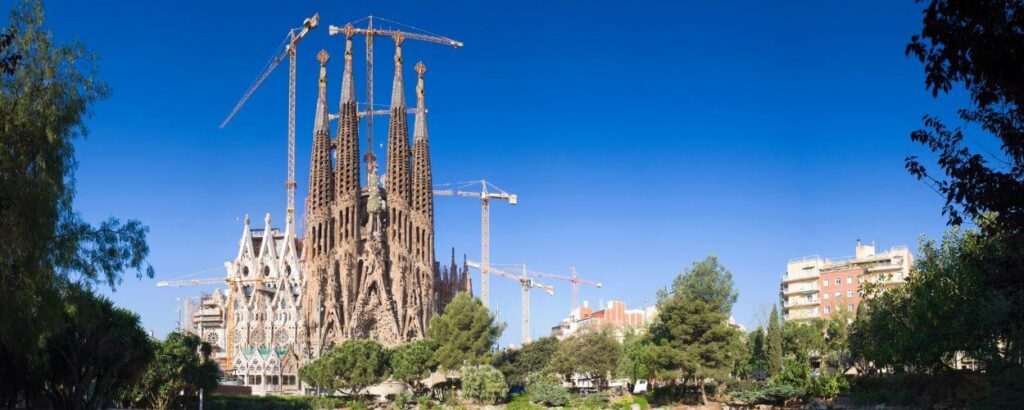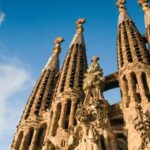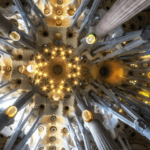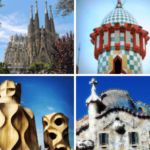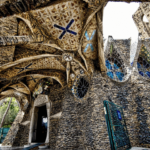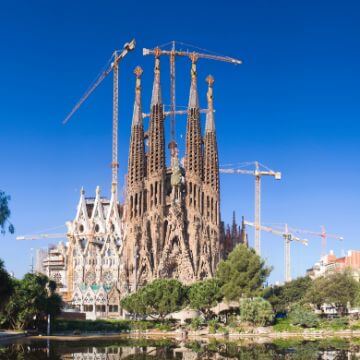
The Nativity Facade of Sagrada Familia
SIMBOLISM AND HISTORY OF THE NATIVITY FAÇADE
The Sagrada Familia Nativity Façade is the side of the church built during Antoni Gaudí’s time. Actually, he first completed the crypt (that was started by the architect Francesc de Paula y del Villar, more information about that here), then he followed with the lower walls of the church apse or backside to reach the exact spot where the Nativity Façade went. The foundations started being dug by hand in 1893, and three years later the walls of the façade were already going up.
So despite what many people may think, this façade isn’t the main entrance of the church: it’s just a side entrance. The main entrance doesn’t exist yet: it’ll go over Mallorca street and it’ll be called the Glory Façade. The Façade of the Nativy, however, is the oldest façade of the Basilica. When Gaudi passed away in 1926, the tower to the left (St. Barnabas) was already finished, and the other were just missing the tips. Domenech Sugranyes, Gaudi’s right hand, continued the construction but due to a lack of funds the completion of the other three remaining towers would still take several years.
After the central cypress tree was completed in 1932 it was time to tackle the sculptures: those on the side gates and the upper levels went first. Unfortunately, the models left by Gaudi were destroyed during the Spanish Civil war. The central creche was finalized in 1958 thanks to a donation, but the next sculptures (the Magi and the sheperds adorations) wouldn’t come until 1981-82. 10 years later came the first angel, the Harp Player, by the Japanese sculptor Etsuro Sotoo, who had entered the sculptors team already in 1978. The statues of the angels were completed in 2000, and that year mr. Sotoo was tasked with the design of the façade doors, which were installed in 2015. The Nativity Façade was finally completed.
La Sagrada Familia Nativity Façade from outside the paid perimeter
1
Where to get a good view of the Nativity Façade
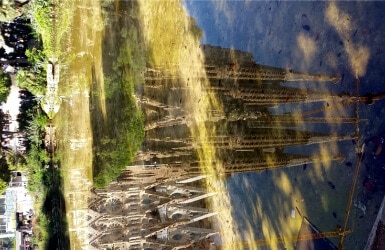
In front of the Façade of the Nativity there's a park with a pond in the middle. The best place to admire the façade is from the other side of the lake. There you'll be able to get a picture of the entire structure, and if you are lucky and the waters are still, maybe even its reflection on the lake. It's also only from that far that you'll be able to see a white sculpture of a pelican, at the foot of the cypress tree. It represents Christian charity - because according to the legend, pelican mothers will feed their babies the flesh of their own belly if they can't find anything else.
Talking about the cypress tree, contrarily to what many will think, it’s not a Christmas tree: Christmas trees aren’t even a Christian thing! They are a pagan tradition from the North of Europe and in Gaudi’s time they weren’t even a thing in Spain yet. Instead, it represents the Tree of Life, that never loses its leaves the same way you should never lose your faith.
The sculptures in the porticoes
Bear in mind that in order to appreciate the most of the details of the statues that decorate the Nativity Façade you’ll have to pay the admission to the church and stand in the platform that extends in front of the façade. From the street you’ll be missing a lot of details and won’t even be able to see some of the sculptures.
The Nativity Façade is divided in three porticos, one for each theological virtue: Faith, Hope and Charity. Each of them is also dedicated to one of the members of the Holy Family: Jesus, Mary and Joseph. Two columns separate the porticoes: at the bottom of each of them there’s a turtle, one a sea turtle, the other a land tortoise. At the top of the columns stand trumpeter angels announcing that Jesus is born.
2
Portico of the Hope
On top of the door you’ll see Jesus as a child showing his father Joseph a injured bird that He’s healed. They are flanked by St. Joachim and St. Anne, Jesus’s grandparents. The next scene further up is Mary and Joseph’s wedding. And even further up but harder to distinguish, there’s Joseph on his boat, under a rock monolith that reminds us of the mountain of Montserrat (Gaudi worked there as a young man designing one of the stations of the Cross of the path to the Holy Cave). The statues of St. Barnabas and St. Simon appear to each side of them – as a reminder that the two left towers of the Nativity Façade are dedicated to them.
3
Portico of the Faith
Right above the door there’s a teenager Jesus preaching at the Temple, surrounded by Zachary and St. John the Baptist. And further up, there’s the presentation of baby Jesus at the Temple. Crowning the portico there’s the Immaculate Conception of the Virgin Mary, surrounded by the apostles Jude and Mathew – to which the right towers of the façade are dedicated.
4
Portico of the Charity
To the left of the central doors there’s the Adoration of the 3 Magi, and to the right the shepherds also bringing presents. Both sculpture groups stand on top of sculpted poultry (roosters, pheasants, turkeys…) which are usually the main course of most Catalan Christmas meals.
From the Creche rises vertically a Star of Christmas, surrounded by angels singing and playing instruments. Gaudi wanted them to play both traditional (guitar, tambourine and fipple flute) and classical instruments (harp, violin and oboe). Some of the singing angels have Japanese traits, because the artist Etsuro Sotoo had converted to Christianity and he wanted to express that angels (and Catholic) can be from any race.
On top of the Christmas Star there’s the Annunciation, the angel telling Mary she’ll be a mother. And if you pay attention, the intricate decoration of the arch that surround it represents the constellations of the starry night on Christmas Eve: the horn of Taurus and one of the two twins of Gemini are the easiest Zodiac signs to spot. Then further up, inside what sort of looks like a cave with stalactites, Jesus crowns Mary as the Queen of Heavens.
The doors of the Nativity Façade
5
Beautiful nature
Behind the leaves and flowers that come out of the metal doors hide small animals: lizards, butterflies, praying mantises, ants, spiders, snails, bees, frogs… In a way, the doors continue the beautiful chaos of natural elements (leaves, flowers, fruit, birds, stars, even a squirrel…) carved in the stone of the façade.
The Sagrada Familia Nativity towers
6
Description and symbolism
These towers are meant to be bell towers, although right now there’s no bells on them yet – if you hear any bells, it’s an electronic Carilion recording. Because of their function, the towers are dotted with hundreds of small windows that will send the sound of the bells towards the ground.
Half way to the top of the towers you’ll notice an inscription: “Sanctus, Sanctus, Sanctus” – Holy, Holy, Holy, in Latin. It’s just one of the many prayers that will decorate the outside of the church, encouraging people to pray and look up to Heaven. There’s more prayers at the tips of the words: “Hosanna Excelsis”, in white letters: Glory in Heaven.
All the 12 towers of the Apostles are crowned by some unusual shapes that represent the symbols of the bishops – since they are the successors of the Apostles on Earth. There’s a cross made of yellow petals, the tip of the tower splits evoking the shape of the bishop’s miter hat, the tower itself represent the bishop cane, and if you pay attention you’ll notice that right under the cross there’s a hole perforating the tower from side to side: that’s the bishop’s ring.
7
Visiting the towers
The regular admission to the Sagrada Familia basilica doesn’t automatically give you access to the towers. Due to capacity restrictions, you must buy a specific ticket that includes the tower rather than the normal admission, and the number of tickets is limited. You’ll be asked to choose between doing the Nativity towers or the Passion towers (you can learn more about that here), but you won’t be allowed to do both towers: it’s one or the other façade. And just like Basilica entrance, the tower tickets are timed and you must be there at your allotted time slot, or they might refuse you access to the tower.
The access to the Nativity Towers is made from the inside of the Basilica, to the right as you enter it. A hostess will check your ticket and scan it, and tell you to leave your bags at the lockers (if you don’t have a coin to lock them, the hostess will lend you a token). The wait to get in the elevator is 5 to 20 minutes, depending on the affluence of public.
The only way up is by elevator, and during the ride a hostess will explain the itinerary around the towers and the safety rules. Most important: the elevator is only to go up: the way down is compulsory done by stairs. This is why the towers aren’t recommended for people with health issues, claustrophobia, fear of heights or even pregnant ladies, and they are forbidden to kids under 6yo.
As you exit the elevator at the top, you’ll have to go up some 2o steps to reach the bridge behind the Tree of Life. This is the best vantage point of the itinerary over the city and the construction works of the central towers. After crossing the bridge your descent starts. At the beginning you’ll have walls in both sides of the staircase, but the last 60m / 200ft become a very narrow spiral staircase with only one wall with a railing in the outer side, then a hole in the center that you can look down through. Bit scary, but the way down is faster than you’d think and in just 2 minutes you’ll be safely reaching the ground level of the church.
RESEARCHING FOR A TRIP IS TIME-CONSUMING…
Need more inspiration?
Our 100% FREE Barcelona Collection will give you everything you need to organize the trip of your lifetime to Barcelona.
BEST INSIDER TIPS FROM THE PROS!


